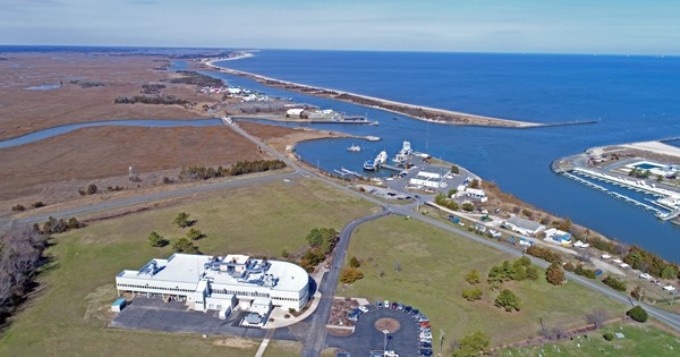Feb 1 2018
Every time an individual uses their car or turns up their thermostat, Carbon Dioxide is released into the air; something that has been taking place since the Industrial Revolution.
 An aerial view of the coast near University of Delaware's Hugh R Sharp campus in Lewes. (Image credit: University of Delaware)
An aerial view of the coast near University of Delaware's Hugh R Sharp campus in Lewes. (Image credit: University of Delaware)
As increasing amounts of carbon dioxide enters the atmosphere, the global ocean seems to soak up much of the excess, storing almost 30% of the carbon dioxide emissions generated from human activities. In this sense, the ocean has indeed performed as a buffer in order to slow down the greenhouse gas accumulation in the atmosphere and, thus, global warming. However, this process also results in increasing the acidity of seawater and can thus affect the ocean ecosystem and the health of marine organisms.
New research by University of Delaware oceanographer Wei-Jun Cai and colleagues at Université Libre de Bruxelles, Texas A&M University-Corpus Christi, the University of Hawaii at Manoa and ETH Zurich, presently discloses that the water over the continental shelves is bearing a huge portion of the load, taking up increasing amounts of this atmospheric carbon dioxide.
The study findings, featured in Nature Communications on Wednesday, Jan. 31, could have significant implications for scientists concentrating on understanding the universal carbon budget.
Understanding how carbon travels between land, water and air is crucial for predicting how much greenhouse gas emissions the atmosphere, earth and ocean can tolerate over a given time period to keep climate change and global warming at thresholds considered to be tolerable.
The study authors used available and historical data from the past 35 years for calculating worldwide trends of carbon dioxide concentration increases in the coastal ocean. The analysis exposed that, while the amount of carbon dioxide in the open ocean is growing at the same rate as in the atmosphere, these same carbon dioxide concentrations are indeed increasing more slowly in the coastal ocean.
This is because the coastal ocean is shallower than the open ocean and can quickly transfer sequestered carbon dioxide to the deep ocean; this process creates an additional and effective pathway for the ocean to take up and store anthropogenic carbon dioxide
Wei-Jun Cai, Mary A.S. Lighthipe Professor in the College of Earth, Ocean and Environment
The coastal zones, though relatively tiny in comparison to the open ocean, are where a huge amount of the carbon dioxide is exchanged between air and water.
If this conclusion is confirmed by future observations, it would mean that the coastal ocean will become more and more efficient at removing carbon dioxide from the atmosphere.
Goulven Lurallue, Key Author and Researcher - Université Libre de Bruxelles, Belgium
Until recently, these trends were very difficult to calculate because of a lack of data about carbon dioxide in coastal waters. Further complicating matters is the fact that coastal zones act differently based on their topography and location. For instance, in higher latitudes such as Greenland and northern Canada, coastal waters generally behave as carbon sinks, absorbing huge amounts of carbon dioxide from the atmosphere. In tropical areas such as the South China Sea, coastal waters are usually treated to be a source of carbon dioxide.
Human activities have, at the same time, increased the amount of nutrient pollution entering coastal waters from things like fertilizer on land. These nutrients are responsible for stimulating the growth of algae within the continental shelves, which consequently removes more carbon dioxide from the atmosphere, the researchers said.
According to the research team, this indicates that the continental shelves are becoming a vital element in the global carbon cycle and also for the climate system.
It is important that scientists take into account the contribution of continental shelves to calculate global carbon budgets. The possibility of shelves becoming a more important carbon dioxide sink in the future should be considered in global carbon cycle models and flux assessments.
Pierre Regnier, Professor at Université Libre de Bruxelles